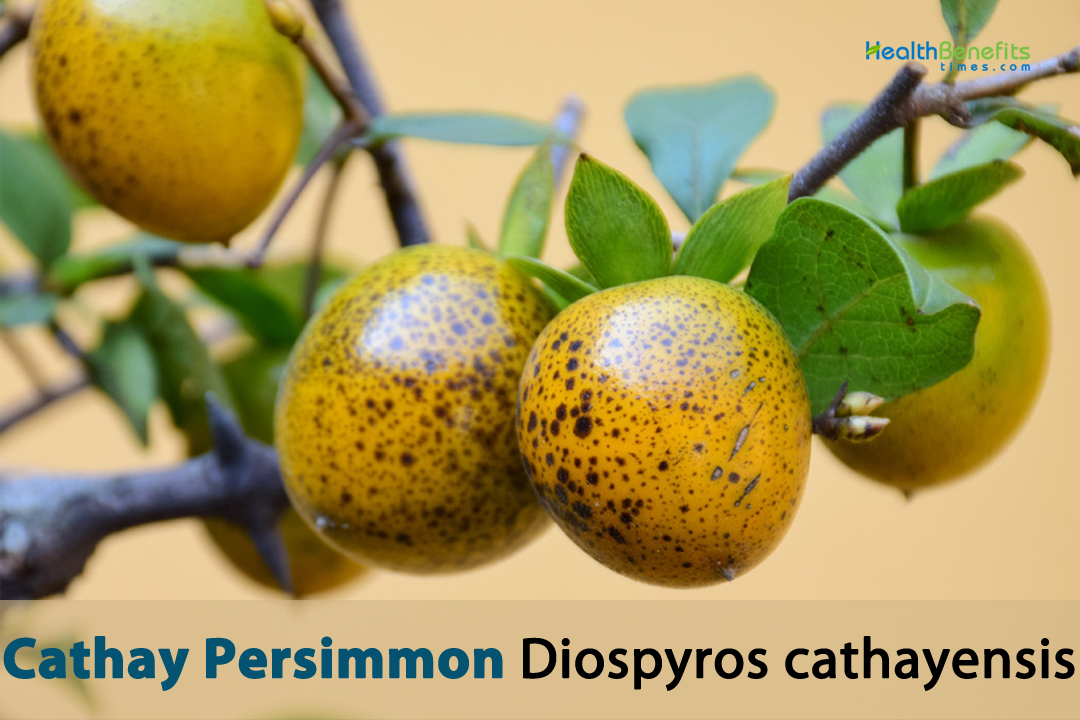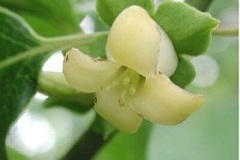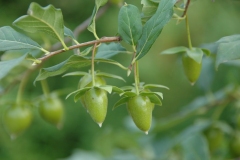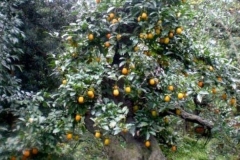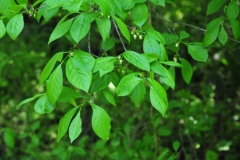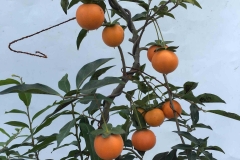| Cathay Persimmon Quick Facts | |
|---|---|
| Name: | Cathay Persimmon |
| Scientific Name: | Diospyros cathayensis |
| Origin | South and western china, Korea, Taiwan and Japan |
| Colors | Orange to reddish-orange color |
| Shapes | Spherical to slightly oval berries, up to 1.2 inches wide |
| Flesh colors | Pale yellow to deep orange |
| Taste | Sweet and mildly tangy flavor |
| Major nutrients | • Vitamin A • Vitamin C • Dietary Fiber • Potassium • Folate • Vitamin E • Phenolic Compounds • Minerals • Antioxidants • Low in Fat and Calories |
| Health benefits | Heart Health, Digestive Health, Weight Management, Bone Health, Skin Health, Eye Health, Immune Support, Cancer Prevention, Regulation of Blood Sugar, Hydration |
| Name | Cathay Persimmon |
|---|---|
| Scientific Name | Diospyros cathayensis |
| Native | Parts of East Asia. It is found primarily in south and western china, Korea, Taiwan and Japan. In china specifically in the provinces of Zhejiang, Anhui, Jiangsu, and Fujian |
| Common Names | Date-plum, Oriental Persimmon, Chinese Date, Lotus Persimmon, Japanese Plum, Chinese Persimmon, Asian Date, Indian Persimmon, Korean Persimmon, Asian Persimmon, Chocolate Persimmon, Japanese Date, Kaki Persimmon, Black Date, Black Persimmon, Japanese Persimmon, Korean Date, Lotus Date, Caucasian Persimmon |
| Name in Other Languages | Arabic: Zahrib (زهريب), Tamr al-jamal (تمر الجمل), Tamr al-sin (تمر الصين), Bersimūn Ṣīnī (برسيمون صيني) Assamese: Chini Phol (চীনী ফল) Bengali: Tetul (টেটুল), Chiku (চীকু), Chīnā Toma (চীনা তমঁ), China Phal (চীনা ফল) Bhili: Chaina Phal (चाइना फल) Bhojpuri: Chaina Phal (चाइना फल) Bodo: Chaina Bathang (চৈনাবাথাং) Chhattisgarhi: Chaini Phal (चायनी फल) Chinese: Shì (柿), Cháshù shì (茶树柿)Dōngfāng Shì (东方柿), wū shì (乌柿) Danish: Kinesisk persimon Dutch: Chinese Diospyros English: Cathay Persimmon Filipino: Kaki Tsina, Cathay Persimmon Finnish: Kiinan persimoni French: Plaqueminier de Chine, Plaqueminier du Japon, Kaki de Chine Garhwali: Chini Phal (चीनी फल) Garo: Chelbak German: Chinesische Dattelpflaume, Chinesische Persimone Greek: Lotós (Λωτός), Lotos Diospiro, Kinezikí rodiá (Κινεζική ροδιά) Gujarati: Tenadi (ટેનડી), Chaina nu Phal (ચાઇનાનું ફળ), Chaini Kayu (ચાયની કાયુ) Hebrew: Kaki Sini (כק”י סיני) Hindi: Chiku (चीकू), China Meetha, Chāīnī Amalā (चाइनी अमला), China Phal Hungarian: Kínai diófa Indonesian: Buah Kaki Cina Italian: Diospiro cinese, Cachi Cinesi Japanese: Kaki (カキ), Jiro Kaki, Tōyō Kaki (東洋柿) Kannada: Tenginamara (ತೆಂಗಿನಮರ), Chaini Hannu (ಚೈನೀ ಹಣ್ಣು), Chaini Kai (ಚೈನೀ ಕಾಯಿ) Kashmiri: Chain Zan (چین ژٔھن) Khasi: Siang, Soh Khlieh Konkani: Chaini Phal (चायनी फळ) Korean: Jang Bae, Gam (감), Dongbanggam (동방감) Kuki: Khawbi Kumaoni: Chini Phal (चीनी फल) Kutchi: Chaini Kayu (ચાયની કાયુ) Nagamese: Chaina Phol (চাইনা ফল) Maithili: Chaina Phal (चाइना फल) Malay: Buah Kaki China, Buah Anggur Belanda, Buah Persimmon Cathay, Cina Buah Malayalam: Karimpana (കരീന്പഴം), Chaini Pazham (ചൈനീ പഴം) Manipuri: China Phol (চীনা ফল) Marathi: Tendu (टेंडू), Chayna Phal (चायना फळ) Mizo: Chhaina Hmarcha Nepali: Chainij Phal (चाइनिज फल) Norwegian: Kinesisk persimon Odia: Chaina Phala (ଚାଇନା ଫଳ) Persian: Khorma (خرما) Polish: Kaki chińskie Portuguese: Diospiro chinês, Caqui Cathay Punjabi: Chuhara (ਛੁਹਾਰਾ), Chini Phal (ਚੀਨੀ ਫਲ) Rajasthani: Chaina Phal (चाइना फल) Romanian: Castravete chinezesc Russian: Lotosovoye derevo (Лотосовое дерево), Kitaiskaya slaiva (Китайская слива) Sanskrit: Shreephala (श्रीफल) Sambalpuri: Chaina Phala (ଚାଇନା ଫଳ) Santali: Chaina Phal (चाइना फल) Sindhi: Chainin Phal (چائنين فل), Chainin Kayu (چائنين کائو) Sinhala: Dodo (දොඩො) Spanish: Caqui chino, Caqui chino japonés, Caqui de China Swedish: Kinesisk persimon Tamil: Theni Kkai (தேனிக்காய்), Caimis Palam (சைமிஸ் பழம்) Telugu: Regu Regu (రేగు రేగు), China Reguti (చైనా రేగుటి) Thai: Makok chin (มะกอกจีน), Lotas (ลอตัส), Ma-feuang Chīn (มะเฟืองจีน) Tulu: Chaini Panu (ಚೈನೀ ಪನ್ನು) Turkish: Çin Hurması, Hurma ağacı Urdu: Chiku (چیکو), Chaini Phal (چائنی فل) Vietnamese: Hồng xứ Lê, Hồng Trung Quốc, Hồng xiêm Đông Á |
| Plant Growth Habit | Extremely rare, evergreen tree |
| Growing Climates | Deciduous and mixed forests, woodlands and wooded areas, open fields, grassy areas, slopes, hillsides, riverbanks and stream sides, orchards and gardens |
| Soil | Well-draining, loamy soils are ideal. They can tolerate a range of soil types but prefer slightly acidic to neutral soils with a pH between 6.0 and 7.5 |
| Plant Size | 15 to 30 feet (4.5 to 9 meters) tall with a trunk diameter of 2.6 feet |
| Root | Primary root system consisting of a single primary root that emerges from the base of the tree. It extends vertically into the soil and plays crucial role in anchoring the tree and providing stability |
| Stem | Stems are brown and tipped in a spine |
| Bark | Smooth and grayish-brown when young become slightly rougher and develop small fissures as they mature |
| Leaf | Leaves are arranged alternately along the branches, leaf blade is the flattened, usually oval or elliptical, upper surface is usually smooth and glossy, while the lower surface is more matte and paler in color |
| Flowering season | March and April |
| Pollinators |
|
| Flower | Small, with a diameter of about 1 inch (2.5 cm), white or pale yellow flowers are borne on cymes during late spring. Overall flower shape is often bell-like or urn-shaped |
| Fruit Shape & Size | Spherical to slightly oval berries, up to 1.2 inches wide |
| Fruit Color | Orange to reddish-orange color |
| Skin | Smooth, thin, and glossy when the fruit is ripe |
| Flesh | Thick, juicy, and sweet when fully ripe |
| Flesh color | Pale yellow to deep orange |
| Seed | Usually small and somewhat flat |
| Flavor/Aroma | Sweet, fruity, and mildly fragrant |
| Taste | Sweet and mildly tangy flavor |
| Plant Parts Used | Leaves, fruits and bark |
| Propagation | By seeds, semi-hardwood cuttings, Grafting |
| Lifespan | Around 50 to 75 years or even longer |
| Season | September and October |
| Major Nutrition |
|
| Health benefits |
|
| Available Forms |
|
Plant Description
Cathay Persimmon is an exceedingly uncommon evergreen tree with a typical height of 15 to 30 feet (4.5 to 9 meters) and a 2.6-foot-diameter trunk. Forests and wooded areas, deciduous and mixed forests, open fields, grassland areas, slopes, hillsides, riverbanks and stream sides, orchards, and gardens are all habitats for this plant. Although the plant can tolerate a variety of soil types, it prefers mildly acidic to neutral, well-draining soils. Cathay Persimmons, similar to other varieties, are rich in dietary fiber, vitamins (especially A and C), and minerals. Furthermore, their high antioxidant content confers advantages to one’s overall well-being.
Certain regions attribute cultural importance to persimmons, including Cathay Persimmons, which are frequently linked to traditional festivities and practices. Cathay Persimmon trees are prized for their ornamental qualities, which include appealing foliage and a graceful growth pattern, in addition to their fruit. Cathay Persimmon trees, being fruit-bearing trees, make a significant ecological contribution by being a food source for numerous fauna species.
Root
The primary root system of Cathay persimmon trees generally comprises a solitary root that protrudes from the tree’s base. It serves a vital function by vertically penetrating the soil and anchoring the tree for stability. Fine roots comprise the greatest number and tiniest portion of the system. Thin, highly branched, and frequently adorned with root hairs—minor projections that augment their surface area—they facilitate efficient absorption of nutrients and water. The root cap comprises a cone-shaped, cellular barrier that provides protection to the root’s actively expanding apical meristem. A structure referred to as the root cap envelops the actively growing apical meristem, which is the most delicate portion of each root, at the apex.
Stem
A number of discrete strata and bodily tissues comprise the stem, all of which are vital for nutrient transportation, growth, and support within the tree. The term “bark” refers to the exterior layer of the stem. Situated in close proximity to the bark, the cork cambium plays a crucial role in both bark development and the establishment of cork cells. Over time, these cork cells undergo demise and integrate into the outer bark’s protective layer. The cortex is a tissue region situated beneath the cork cambium, predominantly composed of parenchyma cells. A narrow layer of meristematic tissue, the vascular cambium, encircles the interior of the stem and divides the xylem from the phloem. It is the responsibility of the xylem, the innermost layer of the stem, to convey dissolved minerals and water from the roots to other areas of the tree. Phloem, which is situated just beyond the vascular cambium, facilitates the transport of organic compounds, nutrients, and carbohydrates generated in the leaves to various locations on the tree.
Bark
Typically, the bark exhibits a silky texture and a grayish-brown hue. With the tree’s maturation, the bark may develop minute fissures and become marginally coarser. Despite this, it is generally unremarkable in comparison to other species of trees.
Leaves
The leaf blade is the photosynthesis-captiting, compressed, green portion of the leaf that is typically oval or elliptical in shape. Frequently, the blade possesses a lustrous, smooth exterior. The leaf blade’s periphery is serrated, which consists of minute, intricate teeth or serrations. An intricate arrangement of capillaries traverses the leaf blade. A straightforward, narrow leaf base connects the plant to the stem. The apex of leaves is generally pointed or marginally declining. Due to the alternating arrangement of the leaves along the branches, each leaf is individually affixed at a distinct location along the stem. Typically, the lower surface of foliage is more matte and pale in color, whereas the upper surface is smooth and glossy.
Flower
Typically, Cathay Persimmon flowers are distributed singly or in small clusters along the leaf axils or branch tips. Although they can differ in size and shape, flowers are typically quite small, measuring about 1 inch (2.5 cm) in diameter. The general form of the flower is frequently bell-shaped or urn-shaped. Although coloration may differ between cultivars, the general range is from pearly white to pale yellow. A few cultivars might have marginally distinct hues or nuances.
Cathay Persimmon blossoms generally consist of four fleshy lobes resembling petals, which are frequently pale yellow or pearly white in hue. The base of each of these sepals is fused. Usually, four sepals comprise the structure, which is further fused at its base. The calyx envelops the corolla’s base. Typically, sixteen stamens are arrayed in two whorls of eight in flowers. Typically lengthier than the petals, these stamens contain pollen-producing anthers. The female reproductive organ of the flower is the pistil, which is composed of the ovary, stigma, and style.
Fruits
Fruits differ in shape from spherical to slightly oval, but are roughly the size of a small tomato on average. The color of mature fruit, which can differ from orange to reddish-orange depending on the cultivar, is smooth and slender. The interior of the fruit is the edible portion. It is sweet, viscous, and thick when completely mature. Contingent on the variety, the flesh may be pale yellow or intense orange in hue. Fruits generally consist of one to multiple seeds. In contrast to the consumption of the fruit’s flesh, the seeds are customarily discarded.
Health benefits of Cathay Persimmon
Cathay persimmon is a fruit that offers a range of health benefits due to its nutritional content and various bioactive compounds. Here are the detailed health benefits of Cathay persimmon:
1. Rich in Vitamins
Cathay persimmons are rich in several B vitamins, in addition to vitamin A, vitamin C, and vitamin K, which are all essential vitamins. Numerous physiological functions rely heavily on these vitamins, including energy metabolism, skin health, blood clotting, and immune support.
2. Antioxidant Properties
Cathay persimmons are rich in polyphenols and antioxidants, including carotenoids (beta-carotene, lutein, and zeaxanthin). By safeguarding cells against oxidative stress and free radical damage, these antioxidants reduce the risk of chronic diseases such as cancer and heart disease.
3. Heart Health
The fiber found in Cathay persimmons facilitates the excretion of cholesterol molecules from the digestive tract, thereby contributing to the reduction of cholesterol levels. This may potentially enhance myocardial health and mitigate the likelihood of developing cardiovascular ailments.
4. Digestive Health
Cathay persimmons contain dietary fiber, which facilitates digestion by encouraging regular bowel movements and averting constipation. Additionally, it promotes a healthy intestinal micro biome, a vital component for optimal digestive health.
5. Weight Management
Persimmons from Cathay are comparatively low in calories and rich in fiber, qualities that may promote sustained satiety and aid in weight management by inhibiting excess.
6. Bone Health
Minerals such as calcium and phosphorus, which are found in these fruits, are vital for the maintenance of robust and healthy bones. Sufficient consumption of these minerals may aid in the prevention of ailments such as osteoporosis.
7. Anti-Inflammatory Effects
Cathay persimmons comprise anti-inflammatory compounds, including tannins and flavonoids. Consistent intake may potentially mitigate inflammation within the body, a factor that is correlated with a multitude of chronic ailments.
8. Skin Health
Vitamin A, which is present in Cathay persimmons, strengthens and repairs cells, thereby promoting healthy skin. An additional antioxidant present in these fruits is vitamin C, which is crucial for the synthesis of collagen and aids in the preservation of skin elasticity and the mitigation of symptoms of aging.
9. Eye Health
Carotenoids such as zeaxanthin and lutein, which are present in Cathay persimmons, are advantageous for eye health. By safeguarding the eyes against oxidative harm, these compounds decrease the likelihood of developing age-related macular degeneration and cataracts.
10. Immune Support
Persimmons from Cathay are rich in antioxidants and vitamins, which aid in the body’s defense against infections and diseases.
11. Cancer Prevention
Antioxidants and phytochemicals found in Cathay persimmons may possess anticancer properties, according to some studies. They have the capacity to counteract the detrimental effects of free radicals and impede the proliferation of cancerous cells.
12. Regulation of Blood Sugar
Initial investigations suggest that Cathay persimmons have the potential to assist in the regulation of blood sugar levels, thereby offering potential advantages for individuals who are afflicted with diabetes or are at risk of developing the condition.
13. Hydration
Due to their high water content, Cathay persimmons can promote healthy epidermis and aid in overall hydration.
Culinary uses
- Fresh Snacking: Freshly harvested Cathay persimmons are easiest to appreciate. They are sweet and have a honey-like flavor when mature. For a nutritious and invigorating snack, simply wash, peel (if desired), and cut into rounds or segments.
- Fruit Salads: Persimmons from Cathay are an exquisite complement to fruit salads. Incorporate these fruits alongside apples, pears, citrus segments, and berries to produce a delectable and vibrant supper. A sprinkle of fresh mint or a drizzle of honey may be used to enhance the flavor.
- Smoothies: Incorporate mature Cathay persimmons into smoothies to impart a creamy consistency and additional natural sweetness. Incorporate them with banana, yogurt, or additional fruits to create a nourishing and delectable beverage.
- Desserts: Cathay persimmons are suitable for many dessert preparations. For a distinctive and delicious take, persimmons can be incorporated into cakes, muffins, tarts, sorbet, or pie.
- Preserves and Jams: Cathay persimmons have the capacity to be transformed into delectable curries, sauces, and preserves. They are an ideal foundation for spreading on toast, muffins, or serving with cheese due to their inherent flavor.
- Salsas: To assemble a delectable salsa, amalgamate diced Cathay persimmons with additional components including red onion, cilantro, lime juice, and a trace of chile to yield a condiment that is both sweet and spicy. This complements grilled fish or poultry well.
- Salad Dressings: Cathay persimmons, blended or mashed, are used to make a tart and sweet salad vinaigrette. Blend them with olive oil, vinegar, Dijon mustard, and additional seasonings to create an original and ad hoc dressing.
- Baking: Persimmons from Cathay can be utilized to impart moisture and natural flavor to baked goods. They function admirably in biscuits, muffins, and bread. In a recipe, puree the persimmon flesh and use that in place of all or a portion of the sugar or oil.
- Sushi and Sashimi: Due to their vivid hue and delicate sweetness, Cathay persimmons are occasionally employed as an embellishment for sushi and sashimi in Japanese gastronomy. They offer a revitalizing juxtaposition to the flavorful undertones present in fish and rice.
- Cocktails: One may pulverize or muddle Cathay persimmons in order to craft one-of-a-kind cocktails. Incorporate them with alcoholic beverages such as vodka or gin, in addition to citrus juice or ginger, to create delectable and invigorating concoctions.
Other Uses
- Ornamental Plant: Cathay persimmon trees are frequently cultivated for their aesthetically pleasing bark and fruit. They can be utilized as ornamental trees in landscapes and gardens, where their vibrant orange fruits and green leaves add visual allure.
- Wildlife Attraction: Avian and small mammalian species may behold the fruit produced by Cathay persimmon trees. This can contribute to the success of conservation efforts and benefit wildlife enthusiasts by supplying sustenance for local fauna.
- Natural Dye: One may utilize the fruit of Cathay persimmons to produce an all-natural orange dye. In some cultures, this dye has been utilized to color textiles and fabrics.
- Woodworking: Utilize the timber for woodworking endeavors. Its fine grain and well-known durability make it suitable for the construction of furniture, cabinets, and decorative objects.
- Hedgerows and Windbreaks: As hedgerows or windbreaks, Cathay persimmon trees can be incorporated into agricultural and natural landscapes to provide shelter, reduce soil erosion, and increase biodiversity.
- Erosion Control: In areas prone to landslides or soil loss, the extensive root system can aid in stabilizing the soil and preventing erosion.
- Firewood and Charcoal: Due to its robust and resilient characteristics, Cathay persimmon wood is utilized as a firewood and charcoal source in certain regions.
- Educational and Research Purposes: By utilizing Cathay persimmons in educational contexts, students can gain knowledge in the fields of botany, horticulture, and ecology. Furthermore, they are utilized as subjects for agricultural and plant biology research.
- Aesthetic and Decorative Use: By incorporating the foliage, branches, and fruits into decorative displays and floral arrangements, one can enhance the aesthetic appeal of both indoor and outdoor environments.
Side effects
- Tannins: Tannins, which are compounds that can induce astringency and a gritty, puckering sensation in the mouth, may be present in Cathay persimmons. Due to the higher tannin content of unripe persimmons, it is crucial to refrain from ingesting them until they are completely ripe in order to prevent this unpleasant sensation.
- Gastrointestinal Discomfort: Ingestion of substantial amounts of fruits rich in fiber, such as Cathay persimmons, within a brief time span may result in gastrointestinal distress. An excess of this substance may cause bloating, gas, or diarrhea in some individuals.
- Allergic Reactions: Although uncommon, certain people may develop an allergy to persimmons. Allergic reactions may manifest as pruritus, edema, urticaria, cutaneous pruritus, or respiratory distress. Irrespective of the suspected allergy, promptly seek medical attention.
- Interactions with Medications: Vitamin K is present in Cathay persimmons and is involved in the process of blood coagulation. Persimmon consumption in excess while taking blood-thinning medications (anticoagulants) may compromise the efficacy of the medication. Please seek the advice of your healthcare provider regarding any dietary restrictions.
- Caloric Content: As with all fruits, Cathay persimmons are composed of calories derived from natural carbohydrates. Although these snacks are nutritious, those on restricted-calorie diets or who have specific dietary restrictions should remain cognizant of their total caloric consumption.
- Dental Health: When ingested in excess, the natural sugars in Cathay persimmons can contribute to tooth decay and cavities. It is advisable to cleanse your teeth or rinse your mouth with water subsequent to consuming persimmons.
- Ripening Process: Some individuals may experience complications if they ingest persimmons prior to their complete ripeness. Extremely astringent unripe persimmons can cause a disagreeable sensation in the mouth. It is crucial to wait until they acquire a sweet flavor and become malleable.
References:
https://www.itis.gov/servlet/SingleRpt/SingleRpt?search_topic=TSN&search_value=896172#null
http://www.efloras.org/florataxon.aspx?flora_id=2&taxon_id=200017566
https://www.inaturalist.org/taxa/870602-Diospyros-cathayensis
https://plants.usda.gov/home/plantProfile?symbol=DICA33


